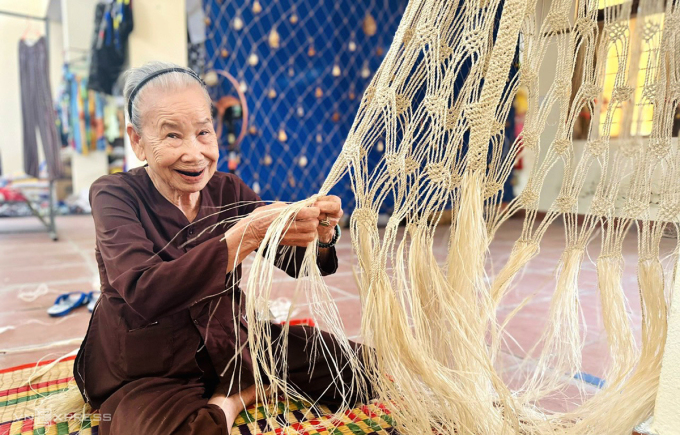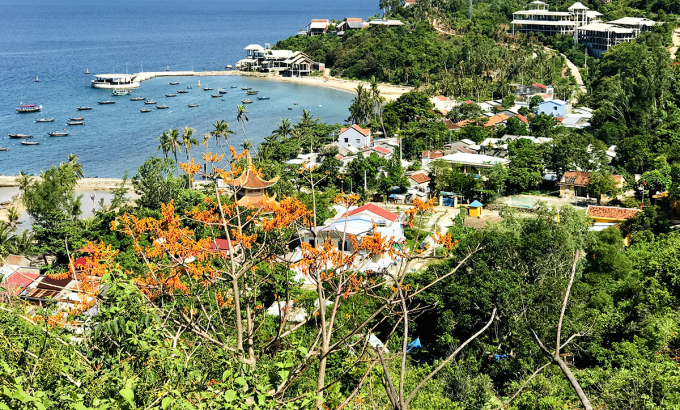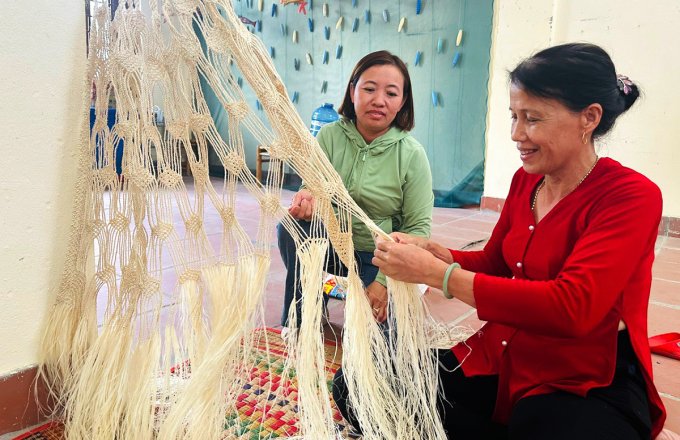Quang Nam: Mrs. Le Thi Ke, 83 years old, on Cu Lao Cham island, meticulously weaved a hammock from parasol tree bark in two months, selling it for 12-15 million VND.
The end of November is the low season for tourism in Cu Lao Cham Island, Tan Hiep Commune, Hoi An City, so there are few tourists. Mrs. Le Thi Ke, carrying a bundle of ivory-colored corn fibers and a knife, sits weaving a hammock in front of her house. Her hands deftly twist each string together, forming successive diamond shapes.

Mrs. Le Thi Ke has been weaving hammocks from parasol tree bark for more than 50 years. Photo: Son Thuy
With over 50 years of experience, he measured the distance between the cells by hand, but it was as neat as a weaving machine. After nearly a month, the hammock was completed, more than a meter long, without any ties or joints, the rope was not frayed but tightly wound. This is the distinguishing feature of the parasol hammock compared to other types of hammocks.
Mrs. Ke was born in mainland Hoi An. In 1962, she married a man on the outpost island of Cu Lao Cham, about 15 km from shore. She learned the craft of weaving hammocks from parasol trees through her mother-in-law's instruction.
Only those who follow the profession understand the elaborate process of making a hammock. "To weave a beautiful hammock, you cannot do it quickly. This profession is more suitable for older people because it requires strict technical requirements in weaving stitches and sewing lines, and requires perseverance and meticulousness," he shared.
Having worked for 10 years on Cu Lao Cham Island, Ms. Huynh Thi Ut said that there are two types of parasol hammocks: 4 strands and 6 strands (the distance between two bundles is 4-6 strands). The weaver must both twist and smooth the strands so that they are tightly tied together, without any lumps or rough joints. When weaving, the weaver must keep an eye on the spacing so that the grids are even, and each knot is tight and secure so that there is no slack.
The 56-year-old woman said that hammocks are handmade so one has to "look at them, learn them, and rely on each person's skill, and cannot hold their hand to show them each stitch and stitch."

Every year in July, the royal poinciana flowers on Cu Lao Cham Island bloom in orange-red. Photo: Son Thuy
On the island, there are many parasol trees growing on the rocky mountains. From April to July is the season when parasol flowers bloom. People go to the forest to find and choose parasol trees and branches as big as a wrist, then cut off the leaves and take the straight trunk.
The tree trunk is crushed, the bark is removed, and soaked in spring water. In the summer, it is soaked for half a month, in the winter for more than 20 days, then taken out and washed. The craftsman chooses the inner bark, which is opaque white, called "manh dong". Manh dong is stripped into small strands, dried until white, and used to weave hammocks.
Mr. Ke explained that cutting down the parasol tree does not harm the forest. In the summer, the tree sheds its leaves, flowers, and then bears fruit. When the fruit falls, young trees grow everywhere, and when they are about three years old, people cut them down to get their bark. "From the cut tree stump, 3-4 new shoots will grow, which will grow into young trees when the rainy season comes," he said.

It took Ms. Huynh Thi Ut nearly half a month to weave half a hammock. Photo: Son Thuy
It takes two months to complete a 2.6 meter long hammock, not including the time to prepare the materials. The hammock can be used for 20 years, and when it gets dirty, it can be washed and dried.
Previously, hammocks made from woven cotton trees were often sold to locals. Since the island developed tourism, many domestic and foreign tourists have bought hammocks for 10-15 million VND each. "Each hammock does not bring in high income compared to the effort put in. But once you do the job, you cannot give it up. If you do not weave every day, you miss it and cannot sit still," said Ms. Huynh Thi Ut.
The people who weave the hammocks do not know when this profession began, only that it has been passed down through many generations. Many people have switched to other professions with higher incomes when Cu Lao Cham Island welcomed more tourists. Currently, the island has only five old people making hammocks and passing on the profession to some young people.
Mr. Nguyen Minh Duc, Vice Chairman of Tan Hiep Commune, said that the hammock making profession is gradually disappearing, so the government has opened classes to teach the younger generation, while also encouraging product diversity and creating space for tourists to experience the traditional profession when coming to the island.
Source link


![[Photo] Keep your warehouse safe in all situations](https://vphoto.vietnam.vn/thumb/1200x675/vietnam/resource/IMAGE/2025/10/1/3eb4eceafe68497989865e7faa4e4d0e)
![[Photo] President of the Cuban National Assembly visits President Ho Chi Minh's Mausoleum](https://vphoto.vietnam.vn/thumb/1200x675/vietnam/resource/IMAGE/2025/10/1/39f1142310fc4dae9e3de4fcc9ac2ed0)

![[Photo] Hanoi morning of October 1: Prolonged flooding, people wade to work](https://vphoto.vietnam.vn/thumb/1200x675/vietnam/resource/IMAGE/2025/10/1/189be28938e3493fa26b2938efa2059e)






























































































Comment (0)